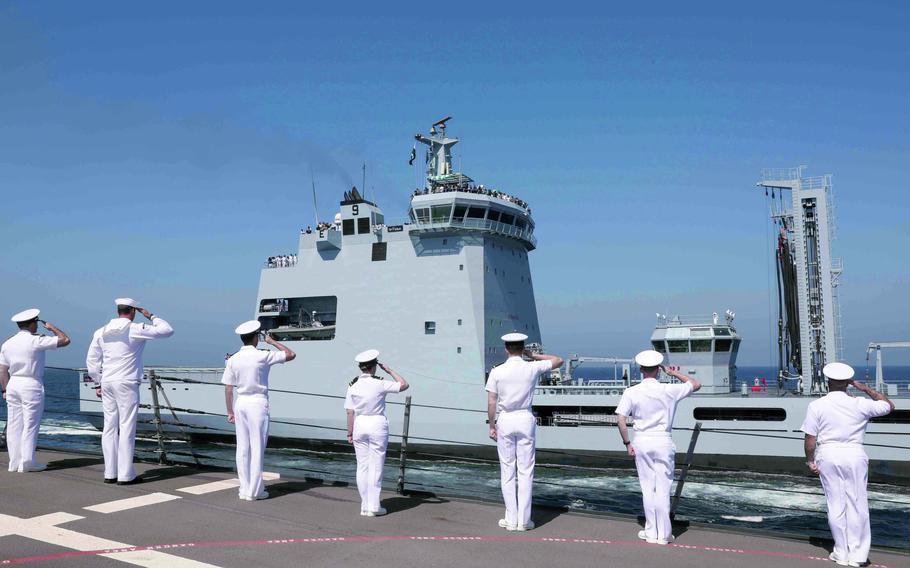
Sailors assigned to the guided-missile destroyer USS Truxtun salute Pakistan Navy fleet replenishment tanker PNS Moawin during exercise AMAN 23 in the Arabian Sea on Feb. 14, 2023. (Kenneth Blair/U.S. Navy)
WASHINGTON — The Navy has mapped out a mental health strategy in a new manual that’s designed to spot potential problems among sailors and address them as soon as possible.
The Navy announced “The Mental Health Playbook” on Tuesday and said the manual aims to help Navy leaders in “preventing, mitigating or addressing mental health issues within their commands.”
“This work begins well before a mental health issue occurs,” the service said in a statement. “It starts with the climate our leaders create and how they lead the people in their care.”
The Navy’s mental health manual comes days after the Defense Department released a report examining the suicide crisis in the military. According to Pentagon data, deaths by suicide across the U.S. military have been on an upward trend for the past 15 years, prompting the Defense Department to introduce programs and tools to provide help to reduce suicides. Defense Secretary Lloyd Austin has pledged to invest millions of dollars in military suicide prevention efforts.
The playbook notes mental health troubles have been a concern in the U.S. military throughout its history and such emotional crises sometimes lead to suicides. Compounding the problem are various obstacles that can make it difficult for sailors to find help and commanders to provide help.
“Sailors may feel more comfortable talking to peers and may be more willing to seek support when it is delivered by a friend,” according to the 28-page manual.
The playbook emphasizes the importance of leaders showing compassion, positive reinforcement and support to sailors who might be struggling with mental health.
“Critical to establishing the right type of preventative climate is eliminating stigma for talking about issues and seeking mental health care,” the manual reads. “There is no better way to do this than for leaders to be transparent and vulnerable, role modeling the behavior they need all hands to practice.”
The playbook identifies three roles for Navy leaders: setting conditions, identifying problems and helping sailors get treatment with minimum interruption.
In setting conditions, leaders should build a climate of trust and respect and eliminate the negative stigma that often accompanies mental health situations, according to the manual. Leaders are then urged to look for behavioral changes and possibly consult experts, and finally help sailors get the treatment that they need while allowing them to remain part of the team.
“Read this handbook from cover to cover in the same way you would read a technical manual for your equipment or a tactical manual to shape your operations,” the playbook states.
The Pentagon-established Suicide Prevention and Response Independent Review Committee wrote in its report released Friday that access to guns is a contributing factor in many suicides in the military. As a result, the group recommended the military target safe storage of firearms, restrict access to firearms at barracks, and set an age limit and waiting period for gun purchases on all U.S. bases.
The committee’s report found guns are involved in two-thirds of active-duty suicides, almost 75% of reservist suicides and 78% of National Guard suicides. By contrast, only about half of all suicides among the general public involved firearms.
The Navy said recently it was taking steps to assign chaplains permanently to all destroyers in the next few years to fill a shortage of mental and spiritual counselors on the warships.
Having access to mental health resources remains an important topic to sailors, given a spate of at least 10 suicides in the past year on Navy aircraft carriers, including the USS Ronald Reagan, USS Theodore Roosevelt and USS George Washington. On the Reagan, three sailors assigned to the same department on the ship attempted to kill themselves between September and November 2022. In April 2022, three suicides aboard the George Washington while it was docked in Virginia for maintenance raised questions in Congress and prompted a Pentagon investigation.
“Too often, mental health concerns are brought to a command’s attention because of the occurrence of a destructive behavior,” according to the Navy’s new manual. “Over the history of the United States Navy, one thing is clear: it is our people that make us great. Use this handbook to build your people up.”